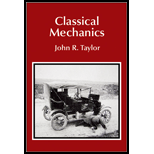
Concept explainers
(a)
The langrangian for two particles of equal masses.
(a)
Answer to Problem 7.8P
The Lagrangian of the two particle system is,
Explanation of Solution
The potential energy of the system is,
Here
Below figure shows the arrangement of the two particles of equal masses. These two particles are connected by a spring.

Here mass 1
The kinetic energy of the two masses is’
Here,
Substitute
The extension of the spring is,
Here,
Substitute
The Lagrangian of the system is,
Conclusion:
Substitute
Therefore, the Lagrangian of the two particle system is:
(b)
The Lagrange equations for new variable
(b)
Explanation of Solution
The position of the centre of mass of the system is,
Solve the equation for
The extension of the spring is,
Solve the equation for
Add the equations (1) and (2) to solve for
Substitute
The velocities of the first and second particle in terms of the position of the centre of mass of the system as follows.
The langrangian of two particle system is,
Substitute
Conclusion:
Therefore, the Lagrangian of the system of two particles in terms of centre of mass of the system is
The lagrangian equation of motion for the two-particle system in terms of
Determine the values of
Determine the value of
Substitute
Thus, the lagrange’s equation of motion for
The lagrangian equation motion for the two-particle system in terms of
Determine the value of
Determine the value of
Substitute
Thus, the lagrange’s equation of motion for
(c)
Solve for
(c)
Answer to Problem 7.8P
The value for
Explanation of Solution
Integrate the equation
Here,
Integrate the equation solve
Here,
Hence the value for
Conclusion:
Solve for the solution for the lagrange;s equation for
Compare the above equation of motion
So, the relative position oscillates with angular frequency
The centre of mass of the system moves as a free particle. This is because of the no external force acting on the system. Hence, two particles oscillate relative to each other.
Want to see more full solutions like this?
Chapter 7 Solutions
Classical Mechanics
 College PhysicsPhysicsISBN:9781305952300Author:Raymond A. Serway, Chris VuillePublisher:Cengage Learning
College PhysicsPhysicsISBN:9781305952300Author:Raymond A. Serway, Chris VuillePublisher:Cengage Learning University Physics (14th Edition)PhysicsISBN:9780133969290Author:Hugh D. Young, Roger A. FreedmanPublisher:PEARSON
University Physics (14th Edition)PhysicsISBN:9780133969290Author:Hugh D. Young, Roger A. FreedmanPublisher:PEARSON Introduction To Quantum MechanicsPhysicsISBN:9781107189638Author:Griffiths, David J., Schroeter, Darrell F.Publisher:Cambridge University Press
Introduction To Quantum MechanicsPhysicsISBN:9781107189638Author:Griffiths, David J., Schroeter, Darrell F.Publisher:Cambridge University Press Physics for Scientists and EngineersPhysicsISBN:9781337553278Author:Raymond A. Serway, John W. JewettPublisher:Cengage Learning
Physics for Scientists and EngineersPhysicsISBN:9781337553278Author:Raymond A. Serway, John W. JewettPublisher:Cengage Learning Lecture- Tutorials for Introductory AstronomyPhysicsISBN:9780321820464Author:Edward E. Prather, Tim P. Slater, Jeff P. Adams, Gina BrissendenPublisher:Addison-Wesley
Lecture- Tutorials for Introductory AstronomyPhysicsISBN:9780321820464Author:Edward E. Prather, Tim P. Slater, Jeff P. Adams, Gina BrissendenPublisher:Addison-Wesley College Physics: A Strategic Approach (4th Editio...PhysicsISBN:9780134609034Author:Randall D. Knight (Professor Emeritus), Brian Jones, Stuart FieldPublisher:PEARSON
College Physics: A Strategic Approach (4th Editio...PhysicsISBN:9780134609034Author:Randall D. Knight (Professor Emeritus), Brian Jones, Stuart FieldPublisher:PEARSON





